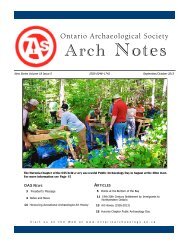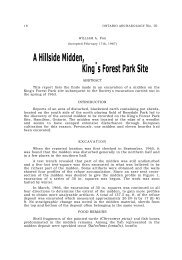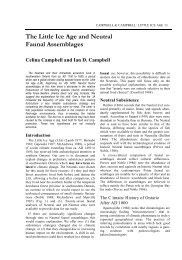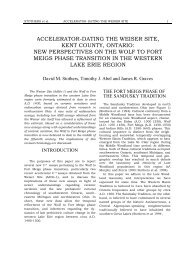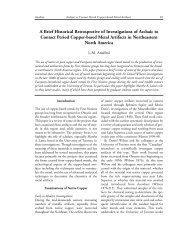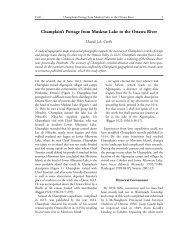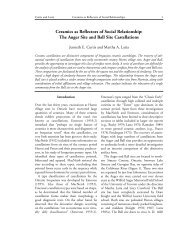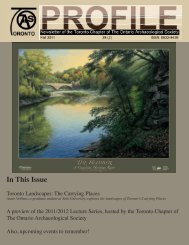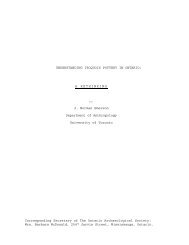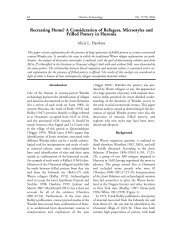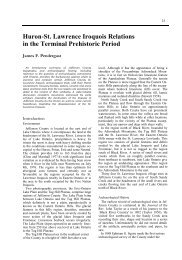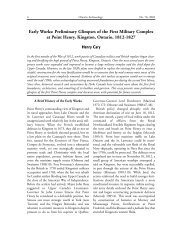part 04 jackson - Ontario Archaeological Society
part 04 jackson - Ontario Archaeological Society
part 04 jackson - Ontario Archaeological Society
Create successful ePaper yourself
Turn your PDF publications into a flip-book with our unique Google optimized e-Paper software.
Jackson New Caribou Fossil Records from Rice Lake 55New Caribou Fossil Records from Rice Lake, South-Central <strong>Ontario</strong>:Radiocarbon Evidence and Middle Holocene Climatic ChangeLawrence J. JacksonThis paper discusses three new radiocarbon dates on fossil caribou bones from Rice Lake, <strong>Ontario</strong>, and theirpossible environmental implications. Three specimens identified by Howard Savage, of the University ofToronto, and Richard Harington, of the Canadian Museum of Civilization, indicate a middle Holocenecaribou presence in this area of south-central <strong>Ontario</strong>. One specimen, previously reported as a possible LatePleistocene record (cf. Pavlish and Alcock [1984] on Webb Bay), is radiocarbon-dated several thousandyears later in the middle Holocene. Zonal pollen in Rice Lake cores suggests the principal occurrence of thesedated Rice Lake caribou during a Hypsithermal warming between about 7,000 and 3,000 years B.P. Thelack of fossil material for the late glacial period (terminal Pleistocene) is believed to correlate with the currentinaccessibility of depositional environments due to flooding of ancient Rice Lake shorelines. The localpresence of Early Palaeo-Indian sites, on the other hand, is highly suggestive of the presence of caribou atthis time. The apparent absence of caribou during the early and late Holocene, as well as lack of evidencefor their human exploitation throughout the Holocene, requires explanation.IntroductionRice Lake is a 26 km long, narrow post-glaciallake basin that connects the Kawartha Lakes withthe Trent River and Lake <strong>Ontario</strong>. It is boundedon the south by the Oak Ridges InterlobateMoraine and on the north by moraine anddrumlin features deposited during the finalSimcoe Ice Lobe retreat, circa 11,500 years B.P.(Gravenor 1957; Karrow et al. 1975; Kaszycki1985). In the course of several surveys for EarlyPalaeo-Indian sites conducted by the author inthe Rice Lake basin, fossil cervid bones wererecovered from lake-edge mechanical dredgings.Radiocarbon dating of these specimens andanalysis of the associated sediments provides significantnew data on the presence of caribou duringthe middle Holocene (Figure 1).Rice Lake Fossil Caribou RecordsWebb BayThe first caribou fossil site recorded in the RiceLake basin was near Webb Bay along the highOak Ridges moraine of the southeast shore(Figure 1). Reported by Pavlish and Alcock(1984), this specimen (a calcaneum) was foundby a geologist during hillside cottage excavation.Dr. Howard Savage, of the University of TorontoFaunal Laboratory, identified this specimen asthe left calcaneum of an adult caribou (Rangifertarandus). He reported that it occurred in a clayloam matrix four feet (1.2 m) below ground surfacein an area of drumlin till. Its context suggestedan age contemporaneous with LakeIroquois in the area (Savage et al. 1981).A Late Pleistocene age for the Webb Bay cariboubone appeared to be a reasonable assumptionsince a possible caribou (recorded as acervine deer) from glacial Lake Iroquois depositsin Toronto had been radiocarbon dated to11,315±325 B.P. (Churcher and Petersen 1982).Radiocarbon dating of the Webb Bay fossil,reported in this paper for the first time, places itmuch later – about 5,000 B.P. in the middleHolocene. This was during pollen subzone 3b, amixed forest with a Tsuga decline, documentedby pollen cores from Rice Lake (cf. Yu 1992).The Webb Bay fossil was found in an activedrumlin slope environment and had evidence ofcarnivore modification. Although it appeared tobe in a late glacial context, it lacked any adheringsediments to permit pollen sum counts for evidenceof associated zonal vegetation. Both circumstances
56 <strong>Ontario</strong> Archaeology No. 69, 2000Figure 1. The location ofsouthern <strong>Ontario</strong> caribousites.now suggest redeposition of the specimen. This isstill an important record of caribou in <strong>Ontario</strong>and raises key questions of ranging behaviourand habitat. The radiocarbon date is 4,950±85B.P. (TO-1107) run by accelerator mass spectrometryon bone collagen.New fossil caribou material recovered by theauthor from two sites at the west end of RiceLake augments the Holocene caribou record andsupports the middle Holocene dating of theWebb Bay caribou. All of the new fossil materialoriginates in shoreline marsh deposits stretchingalong a two kilometre section of the western endof Rice Lake. Figure 2 shows an aerial view to thesouthwest of this shoreline area and historicallyflooded offshore marsh. Light mixed forest andpeat bog covers most of the landward area.Commercial dredging of the peat produced thefossil material. An artificially high water table ismaintained by damming of the eastern Rice Lakeoutlet at Hastings, which began in the nineteenthcentury. Two separate sites, known asPaynter Marsh and Paynter South, at the westend of the lake, produced fossil caribou bones.Paynter MarshLocated near the northwest edge of the Rice Lakebasin, Paynter Marsh is <strong>part</strong> of an extensive wetlandand peat bog developed over the past10,000 years (Figure 3). The age of the bog isprecisely indicated by radiocarbon dating ofwood from the first peat deposit above glaciolacustrineclay at the site. A stratigraphic sampleconsisting of 10.5 grams of wood, collected bythe author in 1987 from a trout pond excavation,dated to 10,000±130 B.P. (Beta-22874). Analysisof pollen from the glaciolacustrine clay and peatcontact (J. McAndrews, personal communication1991) matched <strong>Ontario</strong> pollen zone 1(spruce parkland) typical of the late glacial period.Although slightly young, the date confirms aterminal Pleistocene beginning of peat deposition.A second pollen sample, slightly above thefirst, matches <strong>Ontario</strong> pollen zone 2 (jack pineforest) and confirms the stratigraphic integrity ofzonal pollen deposits at the site. Any fossil bonesfound in peat sediments at Paynter Marsh aremost likely to post-date the beginning of peatdeposition, circa 10,000 B.P.A near-complete left femur of an adult caribou(Rangifer tarandus) was found at Paynter Marshin a dredging pile (Figure 4). Dr. HeatherMcKillop, of Louisiana State University, carriedout preliminary examination of the bone. Itsidentification was confirmed by Dr. HowardSavage, University of Toronto and Dr. RichardHarington, of the Canadian Museum ofCivilization. Analysis of adhering pollen(Weniger 1989) indicated an association with<strong>Ontario</strong> pollen subzone 2a, dated circa 10,000 to
58 <strong>Ontario</strong> Archaeology No. 69, 20000 5cmFigure 4. Left femur of the caribou found at Paynter Marsh. The femur is lacking its epiphyses.8,500 B.P. (Table 1). AMS dating of the femurproduced a later date of 2530±70 B.P. (TO-1092) consistent with pollen subzone 3c (mixedforest). This is the same age as the EarlyWoodland Dawson Creek site one kilometre tothe northeast (Jackson 1979:16).The nature of the marsh deposits at the westend of Rice Lake suggests a probable explanationfor the date of the Paynter Marsh bone beingyounger than the associated sediments. As notedby Haynes (1974:380): “It is common for thesediments in active spring ponds to consist ofsand fluidized by ascending water.... Under theseTable 1. Sediment pollen counts from fossil caribou bones.FemurTibiaTree Species Paynter Marsh Paynter SouthPicea 1 –Abies 2 –Larix 9 –Cupressaceae – 1Pinus 80 40Betula 2 2Quercus 2 12Ulmus 1 3Fraxinus – 1Ostrya – 1Salix – 3Acer saccharum – 12Tilia – 7Carya – 1Tsuga – 6Fagus – 1Alnus – 1Gramineae 2 –Tubuliflorae 1 –Standard Pollen Count 100 100Pteridium 11 –Dryopteris type 4 –indeterminable 1 6Pollen Zone Indicated: 2a 3bAge in Years B.P.: 10,000-8,500 7,500-5,000conditions it is easy for bones ... to penetrate thefluidized sediments and settle out in the bottom.”The location of Paynter Marsh is directlybetween a high and sandy segment of the OakRidges Interlobate Moraine and the west end ofRice Lake, with abundant small creeks andspring seeps nearby. It is highly likely that thePaynter Marsh caribou femur sank in seasonallyfluidized sediments and came to rest in the deepersubzone 2a deposits. In excavating wet sitedeposits elsewhere along the moraine, the authorhas direct experience of wood objects of comparablesize actually sinking to the level of glacialclays and becoming embedded. Radiocarbondating proved them to be much more recent inage than suggested by their apparent stratigraphiccontext.Paynter SouthLess than one kilometre south of the PaynterMarsh site, a second caribou fossil was found, in1988, by Lawrence Jackson Sr. It consisted of a<strong>part</strong>ial left tibia shaft (Figure 5) from an adultcaribou (Rangifer tarandus). This bone wasexposed by the dredging of a stream channel nearits entry into Rice Lake. Identification of thespecimen was confirmed by Savage andHarington, with preliminary work by McKillop.A pollen count was possible from adhering sediments(see Table 1) and suggested a subzone 3bassociation circa 7,500 to 5,000 B.P.AMS dating of a small section of the cariboutibia yielded a date of 3415±85 B.P. (Beta-26660). This places the bone in the period ofsubzone 3c – mixed oak-hickory nut forest afterthe Tsuga decline of subzone 3b. Again, itappears likely that the bone sank into deeper and
Jackson New Caribou Fossil Records from Rice Lake 59Figure 5. Left tibia shaft of thecaribou found at Paynter South.0 5cmolder subzone 3b deposits due to fluidization ofsediments. There is some uncertainty with the100 sum pollen count carried out on sedimentfound in the tibia marrow cavity. This samplelacks Tsuga dominance and has strong counts forQuercus (oak) and Acer saccharum (sugar maple)which could indicate either a subzone 3b or 3cassociation. This could correspond well with theradiocarbon date which places the bone in latersubzone 3c.Bone Sample EffectsThe radiocarbon dating of bone can presentunusual problems for interpretation, most commonlydue to humate contamination of smallcollagen residues that produce dates which aretoo young. The most frequent source of humatecontamination is from groundwater – a majorconsideration at the Paynter Marsh and PaynterSouth sites, which are seasonally water-saturated,but a minor consideration at Webb Bay which isa well-drained till location. All three sampleswere run using Accelerator Mass Spectrometrytechniques (AMS) requiring only small collagensamples. The Paynter South date, run by BetaAnalytic in July of 1988, was adjusted for isotopeeffects 13 C analysis and is in general agreementwith adhering pollen which places it only slightlyearlier than the radiocarbon date. Sample pretreatmentincluded a series of acid washes toremove the carbonate/mineral fraction of thebone, leaching of the extracted bone collagen inalkali to remove humic acids, acidification againand then drying.The Paynter Marsh date, run by the Universityof Toronto Isotrace Laboratory in December of1988, is not in agreement with adhering pollenwhich suggests a much older age. The greaterdepth and total age of marsh deposits in thislocality, as compared to Paynter South (which ismuch closer to the modern lakeshore), however,strongly argues that fluidization of deposits mayhave allowed settling of the bone into older anddeeper layers. The Isotrace Laboratory alsoreports that the purified collagen yield for thissample (TO-1092) was quite good at three percent(R. Beukens, personal communication2000), which tends to add support to interpretationof this date as more secure than the adheringsediments might suggest.The Webb Bay bone, also dated by theUniversity of Toronto Isotrace laboratory inDecember of 1988, had no adhering pollen thatcould be analyzed and the radiocarbon date wasat variance with the presumed context. However,it was noted in the original faunal analysis bySavage (Savage et al. 1981) that the specimen hasbeen subject to carnivore modification, stronglysuggesting its redeposition. The steep hillsidelocation may also argue for secondary transport.The Isotrace Laboratory reports that the purifiedcollagen extract for this sample (TO-1107) wasmuch less, at around 0.7 percent (R. Beukens,personal communication 2000). It is unclearwhether the resulting date for the Webb Bay cariboubone reflects its true age as accurately as thePaynter Marsh sample run by the same laboratory.All three radiocarbon dates for Rice Lake cariboubones are accepted for the purposes of thispaper and are regarded as acceptable minimum
60 <strong>Ontario</strong> Archaeology No. 69, 2000age estimates. The consistency in associationbetween adhering Zone 3 pollen sediments andAMS dating at Paynter South (Beta-26660) confirmsthat bone collagen dating accurately placesRice Lake caribou in the middle Holocene.Rice Lake Caribou Date ImplicationsStorck and Spiess (1994) documented a late glacialGainey phase Early Palaeo-Indian hearthcontaining fragmentary caribou bone at theUdora site just east of Lake Simcoe. Jackson(1998) recorded the Gainey phase Sandy Ridgesite on the northwest shore of Rice Lake, withthe predominant use of the same exotic rawmaterial for tools (Fossil HillFormation/Collingwood chert) as found atUdora, and inferred exploitation of caribou onthe basis of the site’s position overlooking RiceLake, the prevalence of diagnostic end scrapers,and the presence of hearth and pit features. TheSandy Ridge site offers circumstantial evidencefor the presence of caribou at Rice Lake in theLate Pleistocene period. As already noted, a shedcaribou antler is associated with glacial LakeIroquois deposits near Toronto and a possiblecaribou skeleton dated to 11,315 B.P. was foundin Lake Iroquois deposits in the same generalarea. The occurrence of both palaeontologicaland archaeological records of caribou dating tothe Late Pleistocene in southern <strong>Ontario</strong> arguesstrongly for the contemporaneous presence ofcaribou at Rice Lake. A shed caribou antler fromnorthwestern <strong>Ontario</strong> is also radiocarbon datedto 9,940 B.P. ±120 B.P. (AA-3285), documentingthe persistence of the species into the earlyHolocene in northern regions (Jackson 1989).Savage et al. (1981) note that caribou are recordedat the Small Point Archaic Knechtel andInverhuron archaeological sites along the LakeHuron shore of southwestern <strong>Ontario</strong>. Thesesites date between 3,500 and 2,800 B.P. Thereare no other middle Holocene records of caribouin <strong>Ontario</strong>, either from fossil or archaeologicalsites. In the late Holocene, there are isolatedrecords on Iroquoian sites, but it is not knownwhether these specimens may have been acquiredin northern hunting trips or through trade.There is, consequently, only a small data base forpalaeontological or archaeological knowledgeabout caribou in southern <strong>Ontario</strong>.AMS radiocarbon dates for the Webb Bay,Paynter Marsh, and Paynter South fossils indicatea caribou presence in the Rice Lake regionover a 2,500 year span of the middle Holocene(from about 5,000 to 2,500 years B.P.).Calibrated dates suggest that Webb Bay dates toabout 5,700 B.P., Paynter South about 3,700B.P., and Paynter Marsh about 2,700 B.P. A spanof about 3,000 years is suggested (Table 2). Allthree fossils are associated by date with <strong>Ontario</strong>pollen zone 3 or mixed forest. Pollen subzonesidentified in cores from nearby Rice Lake suggestspecific associations for each dated fossil: WebbBay with subzone 3b, mixed forest with Tsugaminimum or decline (4,500 to 4,000 B.P.);Paynter South with early subzone 3c, mixed forestwith Tsuga resurgence and minor fluctuationsin other species; and Paynter Marsh with subzone3c. Actual adhering sediments, subjected topollen analysis, are most useful as referencepoints in suggesting maximum ages for thePaynter Marsh and Paynter South fossils, whichare believed, due to fluidization of sediments, tohave sunk into older deposits.As previously noted, caribou bones are recordedfrom an Early Palaeo-Indian feature at theUdora site in south-central <strong>Ontario</strong> (Storck andTable 2. Radiocarbon intercepts with dendro-calibration dates 1 .Site Name Lab. No. Calibrated Age 1 sigma (68.3%) 2 sigma (95.5%)Paynter Marsh TO-1092 778 B.C. 801-775 B.C. 824-406 B.C.Webb Bay TO-1107 3,777 B.C. 3,813-3,690 B.C. 3,829-3,624 B.C.3,745 B.C. 3,813-3,690 B.C. 3,829-3,624 B.C.3,708 B.C. 3,813-3,690 B.C. 3,829-3,624 B.C.Paynter South BETA-26660 1,700 B.C. 1,860-1,845 B.C. 1,910-1,510 B.C.1,775-1,615 B.C.1 All calculations as provided by laboratories.
Jackson New Caribou Fossil Records from Rice Lake 61Spiess 1994). Coleman (1933) recorded a shedantler of caribou in glacial Lake Iroquois depositsnear Toronto. Churcher and Petersen (1982) alsoreported a cervine deer (which some researchersbelieve is a caribou) from Lake Iroquois deposits.This specimen is radiocarbon dated to 11,400B.P. Clearly, caribou were present in southern<strong>Ontario</strong> during the Late Pleistocene at the sametime as Early Palaeo-Indian peoples. The absenceof Late Pleistocene caribou records for Rice Lakeis most likely due to the fact that the early shorelinesof Rice Lake have been inundated byHolocene rises in lake levels and that anaerobicenvironments for bone preservation since theLate Pleistocene are simply inaccessible (Jackson1997; 1998). early Holocene records of cariboupresent other complications since, not only aredeposits inaccessible, but it is believed that a significantrange shift to northern <strong>Ontario</strong> mayhave occurred due to the incursion of closed jackpine forests. There are presently no data availableto assess the presence or absence of Rice Lakecaribou in the early Holocene.Data presented in this paper bear directly onthe question of middle Holocene presence ofcaribou at Rice Lake. Assuming that extant fossilsare truly representative of a limited, 3,000year middle Holocene caribou presence (between5,700 and 2,700 B.P.), some suggestions may beoffered. Firstly, it appears that Holocene RiceLake caribou are associated only with Zone 3mixed forest after the Tsuga decline. Yu et al.(1996) confirm a middle Holocene warm anddry period, as originally proposed by Terasmae(1973), to explain a major decline in Tsugapollen (a cool climate tree). Beginning about7,500 B.P. with a local transition from marsh toswamp, this warming trend resulted in a dryperiod with significant lowering of Rice Lakewater levels (circa 6,400 to 3,200 B.P. uncalibrated).The three Rice Lake caribou fossils fallneatly within this period. Although it is not possibleto address the question of whether RiceLake caribou were migratory or woodland fromavailable fossil evidence, it appears most logicalthat a warm period incursion into the area wouldcoincide with a southward range shift of eithersubspecies. Vertebrate fossils from Michigan confirma widespread middle Holocene Great Lakeswarming trend (Holman 1990). SouthernMichigan, circa 5,800 B.P., was significantlymilder than in the Late Pleistocene or earlyHolocene. Early Holocene closed canopy pineforests (Zone 2) may have offered unsuitablecaribou habitat (cf. Heard 1997). Northwardrange displacement likely occurred, with newlyexposed lake plains of the Upper Great Lakes(caused by isostatic rebound) attracting cariboufor forage. This may be one reason why a majorityof <strong>Ontario</strong>’s Late Palaeo-Indian sites clusteralong the north shores of Lakes Superior andHuron. A shed caribou antler from northwestern<strong>Ontario</strong> is dated to 9,940±120 B.P. (cf. Jackson1989), coeval with early Holocene human occupations.As noted by Kelsall (1968), the presence ofsuitable lichens and other forage determines thecapacity of an area to support caribou. Calef(1981) remarks that caribou on the barrens selectsedges and horsetails – which grow in wet environments– and will wade deeply to obtain them.Middle Holocene Rice Lake shoreline habitats,in spite of a warmer and drier climate, hostedsuch plants. Yu (1992) records sedges at PaynterMarsh coincident with western basin flooding.One argument against a significant presence ofcaribou in the Rice Lake region during a middleHolocene hypsithermal is the apparent absenceof this species from archaeological sites in theregion. Although a large number of precontactsites, ranging from Late Archaic to LateWoodland in age, have produced deer remains(often in abundance), no caribou have beenidentified. Some of these sites are shown inFigure 6 and include: Sandy Ridge, an EarlyPalaeo-Indian site on the north shore; Halstead,a similar site on the south shore; McIntyre, a LateArchaic site on the north shore; Dawson Creek,an Early Woodland site on the northwest shore;Serpent Mounds, a Middle Woodland site on thenorth shore; and Willow Point, a submergedMiddle Woodland site on the south shore.Factors of preservation and expertise in identificationmay contribute to the archaeologicalinvisibility of Rice Lake caribou.Caribou may not have been present in south-
62 <strong>Ontario</strong> Archaeology No. 69, 2000Figure 6. Caribou fossil and archaeological sites of the westernRice Lake basin.central <strong>Ontario</strong> during certain periods, such asZone 2 pine dominance (10,000 to 7,500 B.P.)and succeeding Zone 3a early mixed forest(7,500 to 5,000 B.P.). The present study suggestscaribou presence during Zones 3b and 3c (mixedforest) at a time of climatic warming.Paradoxically, caribou might favour a warmerand drier environment if there was greater availabilityof water plants for forage. Flooding of lakebasin margins by progressive isostatic reboundenhanced such conditions circa 5,700 to 2,700years B.P.SummaryNew radiocarbon evidence from three fossil caribousites in the Rice Lake region of south-central<strong>Ontario</strong> indicates a middle Holocene presence ofthis species (Rangifer tarandus) during a hypsithermal(warming) period. AMS dating ofbones documents an age span of about 3000years (from 5,700 to 2,700 B.P.) and supportstheir association with mixed forest pollen subzones3b and 3c. Caribou may have been locallyabsent during the earlier Zone 2 (pine forest) andZone 1 (spruce parkland) periods, as well as duringsubsequent Zone 4. Since caribou are presentelsewhere in southern <strong>Ontario</strong> during Zone 1(both archaeologically and palaeontologically),the lack of Rice Lake fossils of this period isbelieved to be connected to sampling, <strong>part</strong>icularlysince natural areas of fossil bone depositionalong old shorelines of Rice Lake are flooded byhigher Holocene lake levels. The absence of caribouthroughout southern <strong>Ontario</strong> during zone 2and presence of a dated specimen in northern<strong>Ontario</strong> at this time suggests a possible northwardrange shift. This tends to be supported byan abundance of Late Palaeo-Indian sites innorthern <strong>Ontario</strong> in the early Holocene. Duringthe middle Holocene climatic warming, caribouare documented by dated fossils at Rice Lake.Accelerated northern glacial melt, accompaniedby isostatic rebound and flooding of the westernRice Lake basin, may have created attractive localaquatic environments for caribou forage duringthis period. The local absence of caribou remainson all archaeological sites remains unexplained.The dated Rice Lake fossils support a lengthyperiod of middle Holocene caribou presence inthe region and answer at least some questionsraised by the early work of Howard Savage.Acknowledgements. This paper has benefitedfrom the assistance of many people, includingcrew members who worked on several archaeologicalprojects through the 1980s and 1990s. Iwould like to thank Jane Weniger and JohnMcAndrews for pollen analyses, HeatherMcKillop, Scott Gibbs, Lawrence Jackson Sr.,Donna Morrison and Don Simons for their helpin searching for fossils, and the late HowardSavage and Dick Harington for generous assistancewith identifications. Dr. Savage also graciouslymade the Webb Bay fossil available forradiocarbon dating. Thanks also to the anonymousreviewers who provided helpful commentsand to Phil Woodley for his comments on anearly draft of this paper. Research into the RiceLake fossil record was funded by the <strong>Ontario</strong>
Jackson New Caribou Fossil Records from Rice Lake 63Heritage Foundation (research grant ARG-136)and by Social Sciences and Humanities ResearchCouncil of Canada survey grants in 1984 and1985.References CitedCalef, G.1981 Caribou and the Barren Lands. Firefly Books,Scarborough, <strong>Ontario</strong>.Churcher, C.S., and R.L. Peterson1982 Chronologic and EnvironmentalImplications of a New Genus of Fossil Deerfrom Late Wisconsin Deposits at Toronto,Canada. Quaternary Research 18:184-195.Coleman, A.P.1933 The Pleistocene of the Toronto Region. AnnualReport of the <strong>Ontario</strong> De<strong>part</strong>ment ofMines 41, Part 7. <strong>Ontario</strong> De<strong>part</strong>ment ofMines, Toronto.Gravenor, C.P.1957 Surficial Geology of the Lindsay-PeterboroughArea, <strong>Ontario</strong>, Victoria, Peterborough,Durham, and Northumberland Counties,<strong>Ontario</strong>. Memoir 288. Geological Survey ofCanada, Ottawa.Haynes, C.V., Jr.1974 Paleoenvironments and Cultural Diversityin Late Pleistocene South America: A Replyto A.L. Bryan. Quaternary Research 4:378-382.Heard, D.C.1997 Causes of Barren Ground CaribouMigrations and Implications to Hunters. InCaribou and Reindeer Hunters of theNorthern Hemisphere, edited by L.J. Jacksonand P. Thacker, pp. 27-31. Avebury,Glasgow, U.K.Holman, J.A.1990 Vertebrates from the Harper Site and RapidClimatic Warming in Mid-HoloceneMichigan. Michigan Academician 22:205-217.Jackson, L.J.1979 Dawson Creek: An Early Woodland Site inSouth-Central <strong>Ontario</strong>. <strong>Ontario</strong> Archaeology33:13-36.1989 Late Pleistocene Caribou from Northern<strong>Ontario</strong>. Current Research in the Pleistocene6:72-74.1997 Caribou Range and Early Palaeo-IndianSettlement Disposition in Southern Canada.In Caribou and Reindeer Hunters of theNorthern Hemisphere, edited by L.J. Jacksonand P. Thacker, pp. 127-159. Avebury,Glasgow, U.K.1998 The Sandy Ridge and Halstead Paleo-IndianSites: Unifacial Tool Use and Gainey PhaseDefinition in South-Central <strong>Ontario</strong>. Memoir32. Museum of Anthropology, University ofMichigan, Ann Arbor, Michigan.Karrow, P.F., T.W. Anderson, A.H. Clarke, L.D.Delorme, and M.R. Sreenivasa1975 Stratigraphy, Palaeontology, and Age of LakeAlgonquin Sediments in Southwestern<strong>Ontario</strong>, Canada. Quaternary Research 5:49-87.Kaszycki, C.A.1985 History of Glacial Lake Algonquin in theHaliburton Region, South-Central <strong>Ontario</strong>.In Quaternary Evolution of the Great Lakes,edited by P.F. Karrow and P.E. Calkin, pp.109-123. Special Paper 30. GeologicalAssociation of Canada, St. John’s, Nfld.Kelsall, J.P.1968 The Migratory Barren-Ground Caribou ofCanada. Canadian Wildlife Service, Ottawa,<strong>Ontario</strong>.Pavlish, L.A. and P.W. Alcock1984 The Case of the Itinerant Bone: the Role ofSedimentological and GeochemicalEvidence. Journal of Field Archaeology11:323-330.Savage, H.G., L.J. Jackson, and H. McKillop1981 Post-glacial Caribou in Southern <strong>Ontario</strong>.Paper presented at 8 th Annual <strong>Ontario</strong><strong>Archaeological</strong> <strong>Society</strong> Symposium,Toronto. Ms. on file, Northeastern<strong>Archaeological</strong> Associates, Port Hope,<strong>Ontario</strong>.Storck, P.L., and A. Spiess1994 The Significance of New FaunalIdentifications Attributed to an EarlyPalaeo-Indian (Gainey Complex)Occupation at the Udora Site, <strong>Ontario</strong>,Canada. American Antiquity 59:121-142.Terasmae, J.1973 Notes on Late Wisconsin and EarlyHolocene History of Vegetation in Canada.Arctic and Alpine Research 5(3):201-222.Weniger, J.1989 Pollen Count Data for Paynter Marsh andPaynter South Fossil Sediments. Ms. on file,Northeastern <strong>Archaeological</strong> Associates, PortHope, <strong>Ontario</strong>.
64 <strong>Ontario</strong> Archaeology No. 69, 2000Yu, Z.1992 Postglacial Water Levels at Rice Lake, <strong>Ontario</strong>:Sediment, Pollen, and Plant MacrofossilEvidence. Unpublished MSc thesis,De<strong>part</strong>ment of Botany, University ofToronto, Toronto.Yu, Z., J.H. McAndrews, and D. Siddiqi1996 Influences of Holocene Climate and WaterLevels on Vegetation Dynamics of aLakeside Wetland. Canadian Journal ofBotany 74:1602-1615.Lawrence J. Jackson,Northeastern <strong>Archaeological</strong> Associates,P.O. Box 493, Port Hope, <strong>Ontario</strong>, Canada L1A 3Z4ljnortheast@sympatico.ca



